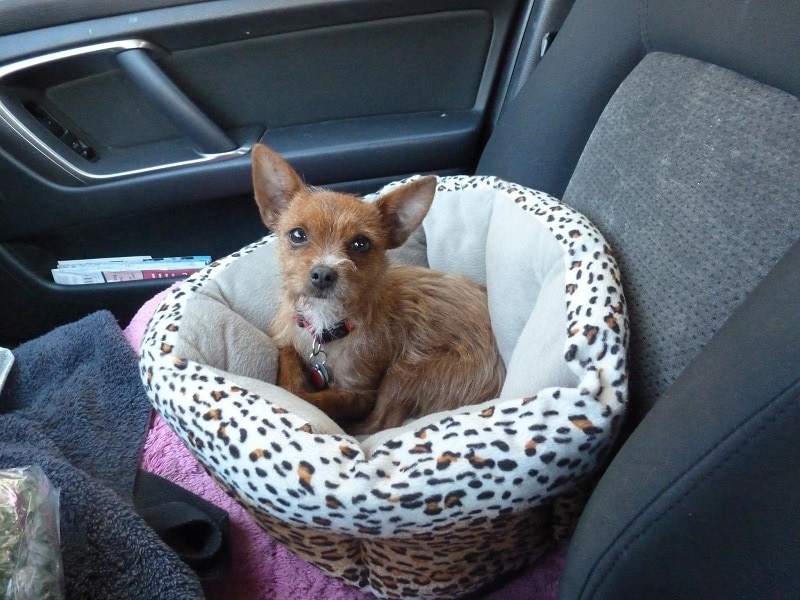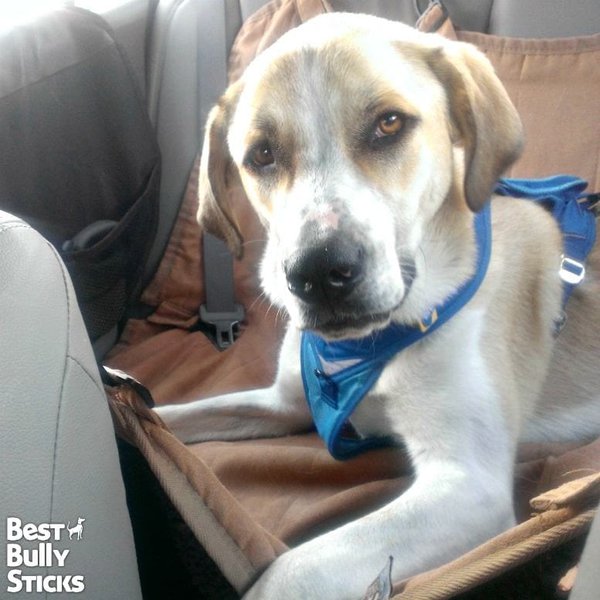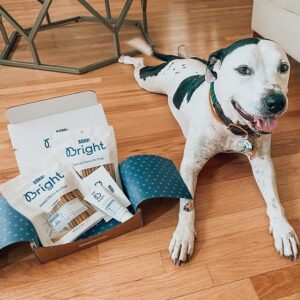The best dog car seat is K&H Bucket Pet Booster Seat.
Dog car seats (also known as dog booster seats) provide you with safety and security while driving around with your canine companion.
These car seats are designed to keep your dog properly restrained during car rides while giving it a good view of you and your surroundings. This helps to prevent your dog from engaging in distracting behaviors – such as physically jumping across the front seat and dangerously obstructing you while driving.
Do take note – these dog car seats are typically more suitable for smaller-sized dogs. For larger-sized dogs, a dog crate or a dog car harness might be the better option instead.
Here are 7 of the best dog car seats that come highly recommended by satisfied dog owners.
#1 K&H Bucket Pet Booster Seat
Shaped like a bucket, this product will soon turn into a favorite for your dog because it will feel safe and secure in it, even during a bumpy ride. Available in various sizes, it is not the cheapest, but it certainly is the best protection for your little friend.
The interior is lined with snug fleece, and the seat has been designed to fit in the front or the back seat of the standard vehicle. What’s more? It comes attached with a leash which can be used as a seat belt for your dog and can be attached to the harness.
The snug fit, along with the easy-to-get in-and-out feature, will be appreciated by both you and your dog. The elevated view that the booster provides makes sure that the little one is not craning and, in the process, ends up injuring itself during a ride.
What tilts the scales in the favor of the K&H dog seat is the presence of dual safety leashes which provide the additional security small dogs need in a drive. These booster seats with the 3-inch foam cushion provide the required height to see outside the window during travel.
Pros
- This booster seat comes with an elevated bottom that makes it possible for pooches to enjoy a view of the environment during road trips.
- The booster seat can be securely buckled in with car seat belts, and it also has two adjustable security tethers that keep pooches in place while the vehicle is in motion.
- The zippered quilted fleece cover of this booster seat can be easily removed and washed in a machine for convenient maintenance.
- This dog booster seat has raised firm foam bolsters around its edges to help keep a dog’s movements in check while on a trip.
- The design of this K&H booster seat features a contoured back that fits snugly with different car seats.
Cons
- This pet booster seat isn’t crash-tested or designed to keep pooches safe in the event of an accident or emergency stop.
- Several customers claim that this booster seat’s safety tethers tend to slide and twist together, causing pooches to be ejected out of the seat, and may even pose a strangling risk.
The top pick goes to this product because it comes with not one but two security tethers for added safety, and it employs an elevated design to allow dogs to enjoy the panoramic view during car rides.
#2 PetSafe Happy Ride Jumbo Booster Seat
A good 9 inches above the vehicle seat, this jumbo dog booster seat will become your pet’s cherished car seat as it will no longer be hindered by its lack of height. The seat has a firm interior structure based on the T-Core technology making it super strong and yet surprisingly lightweight. It has been tested in a DOT-approved facility for sturdiness and durability.
An easy-to-assemble set, the Solvit Jumbo Booster Seat is well padded and comfortable. Even with the safety belts on, it remains so spacious that should your dog wish to lay down and relax, it can without feeling cramped.
This is our choice not only because it is affordable but comes with the safety features of all top brands. In fact, with all the features of a top brand, you can shave a good 20% of the cost when you invest in this model. It is quality and cost in one piece.
Pros
- This jumbo booster seat comes with a quilted plaid liner to ensure that pooches remain comfortable on trips.
- This booster seat’s removable cover is machine washable, making maintenance easy for customers.
- This PetSafe booster seat includes a Happy Ride seat belt tether for keeping pooches in place during trips; customers can also separately purchase and use the crash-tested Happy Ride Safety Harness with this booster seat.
- The lightweight design of this jumbo booster seat makes it easy to carry and transport from one place to another.
- The booster seat features a sturdy plastic construction that is designed to resist wear and tear and last for a considerable period.
Cons
- The absence of an opening on the sides of this jumbo booster seat makes it difficult for some pooches to climb into.
- Customers claim that the pillow that comes with this booster seat is too thin for comfort, and it slides around a lot, which is uncomfortable for most dogs.
#3 Snoozer Lookout Car Seat
Comfortably foamy interiors provide the perfect cushion and height for your pet when inside your car.
The Snoozer dog car seats are available in several colors. The nylon quilted external cover ensures that the booster seat stays neat for a reasonable amount of time. Luxurious to look at, this booster seat will certainly please the most demanding of dog owners.
Sherpa lined and nylon quilted, the Snoozer lookout seat is ideal for medium-sized dogs. The seat is supposed to reduce the incidence of car sickness in your pet because of its stability and comfortable interiors.
Pros
- The poly-cotton cover of this car seat is soft to the touch, and this combines with memory foam padding to provide the ultimate comfort for pooches on trips.
- The zippered cover of this car seat can be easily removed for convenient machine washing and maintenance.
- The elevated design of this car seat is ideal for pooches that get carsick easily because pooches can look out of the car window, thereby helping to eliminate anxiety while on trips.
- This Snoozer product can be hooked into a car’s seat belt system for easy installation.
Cons
- This car seat’s tether tends to slide around on seat belts, which makes it possible for pooches to get out or be ejected from the car seat.
- Some customers claim that this car seat’s plush top sheds a lot.
#4 Petsfit Booster Seat & Lookout Car Seat
You can have all your pet needs in one place with this dog seat with pockets. It provides the height and is comfortable to use. It is also spacious enough for large dogs.
The liner is removable and washable; you can use it on either side. The leash ensures that the pet doesn’t get up from its seat.
However, some users have mentioned that the leash can be rather flimsy and tends to break. So this car seat might not be suitable for really strong dogs.
The Petsfit booster seat has two things going for it – its double-sided reversible cover and storage pockets for storing all the pet-related stuff. Large and spacious, you can be sure that your pooch adapts to it really soon.
Pros
- The Petsfit car seat comes with storage bags for holding a pooch’s daily necessities, such as treats, toys, and food, among others.
- The elevated design of this booster seat makes it possible for dogs to sit up and look outside the car window while on trips.
- This product comes with sturdy safety buckles and fixing webbings for keeping the booster seat in place and reducing sudden movements.
- Installation of this product on a car seat is easy, and customers can also fold the booster seat to store it when not in use.
- The double-sided cushion of this booster seat is removable and can be machine washed for convenient maintenance.
Cons
- Customer feedback suggests that this car seat’s padding tends to sink and lose the ability to elevate pooches to look outside the car window.
- The edge of the Petsfit booster seat is too hard for pooches to comfortably rest their heads while on trips.
#5 Amazon Basics Pet Bucket Booster Seat
Simple yet functional, this bucket-sized booster seat is meant for small dogs who like to be comfortable at all times. Designed to fit in both front and back seats, this booster seat will give the elevation required for your pooch to look outside.
The booster seat is also lined with durable oxford fabric on the sides and comes with an adjustable leash that makes it easy to pair with the car seat belt.
Almost $30 less than the top brand, the amazon basics dog seat is designed for easy entry and exit while providing ample side support and bottom cushioning. It is ideal for a small-sized dog.
Pros
- This product has a lowered side that makes it convenient for pooches to get into and out of the booster seat.
- The Amazon Basics booster seat has a quilted flannel plush top that provides cozy comfort for dogs while on trips.
- The elevated design of this pet bucket seat provides dogs with a better view out the car window.
- The booster seat’s mat cover is removable and can be machine washed with cool water and mild detergent for easier maintenance.
- The Amazon Basics booster seat is lightweight and can be conveniently carried to and from a car.
Cons
- The straps intended to keep dogs in place are attached to the booster seat’s fabric and not the product frame, which makes it possible for excitable pooches to jump out of the booster seat.
- Some customers claim that the material used in constructing this booster seat is too thin to keep their pooches comfortable on car rides.
#6 Snoozer Luxury Lookout II Pet Car Seat
When you want your pet to enjoy some luxury this micro sued covered pet seat should come to mind. Plush cushioning pull-out tray and micro sued washable cover are the highlights of the seat.
If you want to indulge your pet, then go for this pricey seat. But do take note, it costs more than 2 times the price of our top pick. To be fair, the material, the construction, and the comfort of the seat are worth the price.
Pros
- The Snoozer car seat is covered in luxurious microsuede material that is comfortable for pooches to rest on during car rides.
- The raised seat design of this car seat product makes it possible for pooches to look out the window during car rides, thereby helping to reduce anxiety.
- The Snoozer Luxury car seat features a pullout drawer for conveniently storing pet supplies and accessories such as treats, toys, and leashes.
- Installation and removal of this Snoozer Luxury product are straightforward, and the pet car seat is lightweight and easy to move to and from a vehicle.
- The zippered microsuede cover of this pet car seat is removable and can be machine-washed for easier maintenance.
Cons
- Customers claim that the car seat’s arms are too soft to provide adequate support for a dog’s head and that these arms may collapse with continued use.
- Customers also claim that the Snoozer car seat’s pillow is overstuffed and too high for dogs to conveniently lay on without sliding off.
#7 Kurgo Skybox Booster Seat For Dogs
The T-Core technology and the related firm structural body form the heart of the seat. The ultra-strong tether and the adjustable inner leash ensure your pet has a smooth ride every time you take it along with you. Your pet gets a full 9-inch elevation on this seat.
It comes in black and orange colors too.
When you want a large spacious car dog seat, you must select one that is sturdy, durable, and tested for strength. The Kurgo Skybox is all this and more and priced reasonably, too, when compared with others with similar features.
Pros
- Kurgo Booster Seat for dogs comes with an adjustable belt tether design that can be attached to a pooch’s harness to keep it in place during trips.
- This booster seat comes with zippered pockets for storage of dog treats, toys, leashes, and other accessories.
- The metal supports of this booster seat for dogs are collapsible for easy storage.
- The elevated design of this booster seat provides pooches with a window view that they can enjoy while on car rides.
- The Kurgo Skybox booster seat can be attached to car seat belts for easy installation.
Cons
- The enclosed bucket design of this product doesn’t facilitate better air circulation, making the booster seat become too warm for a dog to be seated in after some time.
- Several customers remarked that this dog booster seat was too small for their small-sized pooches to conveniently lay in.
Why Do You Need A Dog Car Seat?
While on the road, it is crucial that you keep all distractions away, including a sprightly pet. If you take your four-legged friend on long drives, a car seat for the dog becomes mandatory. It ensures the safety of the pet from sudden stops but also the safety of the driver.
Dogs tend to get anxious and restless while riding in cars, and that adds to additional movement. But when comfortably straddled in a well-designed car seat, they feel secure and safe.
As a result, they are less likely to be agitated.
Finally, small dogs are always challenged by their height and unable to view the scene outside. But with car booster seats, they gain good height and can enjoy the scenery around them as much as you. This would not be a problem for large dogs, but not until they have grown to their adult size.
How Do They Work?
The best dog car seats, also known as dog booster seats, are specifically designed to keep your pet safe even if you are involved in an accident. They are subject to rigorous testing just like any other car seat. They usually are a bucket-shaped or rectangular shape with high walls and come with a safety harness that can attach them to the regular car seat.
The booster seats are spacious for the dog to sit comfortably without giving them any additional space for movement during a ride. However, more often than not, booster seats are usually applicable only to small dogs who have difficulty getting a view of the world beyond the car window.
Most dog car seats are not crashed tested, they will not provide adequate protection for your dog during a car accident. Pupsaver is one dog car seat that has been crash-tested – which has a rear-facing design that will catch your dog upon impact and act as a protective barrier to prevent contact with hard surfaces.
Related: Best Dog Car Barriers
2 Different Types Of Dog Car Seats
- Bucket-shaped: Booster seats shaped like a bucket give an elevation to the dog for a vantage position. You can tether the dog to its seat, and the dog harness can be attached to the car seat belt system.
- Bed-shaped: These are not exactly booster seats. These are longer and more comfortable models suitable for long drives, usually at the expense of an elevated height. While these might not be the best choice for small dogs, we would recommend these for dogs with a nervous disposition.
Tips On Choosing The Best Dog Car Seats
It is not easy to choose a suitable car seat for your dog from a variety of products. It requires hours of research and pouring over product reviews and customer feedback. We have made the job easier for you by compiling all the necessary guidelines to make the right choice
- Size: A good car seat must be the right size. Consider the length and width of the car seat before buying. Check the weight of the car seat to ensure the safety of the pet. If you are buying it for puppies or small dogs, you must buy a seat that the little fellow can grow into.
- Installation Features: There are different methods of attaching a dog car seat. Some models require a headrest to hang them; some use the car’s seat belt to secure them, and others will even use the console.
- Easy To Use: The seat must be easy to install and uninstall besides being easy to store too. Not only must it be easy for your pet to get in and get out when unleashed. The leash must be adjustable.
- Protection Feature: The thickness of the padding plays a vital role in car seat selection. Ensure the seat has at least two inches of padding for protection from crashes and bumps to your pet.
- Car Seat Cover: To maintain hygiene, the car seat must be removable and washable. Even the material used for the cover must be non-allergenic for your pet. You must be able to wipe clean the material.
Related: Best Dog Car Ramps

Getting Your Dog Used To A Car Seat
The next step is to get your furry friend acclimatized to the dog car seat and use it optimally. It requires patience and a well-planned strategy.
You can start with short practice sessions in your house. Use food and treats to entice it to use the seat for short periods of time. Encourage the dog to get in and sit for some time first; next, follow it up with buckling it up – you might find resistance, but always be patient.
Ensure every session ends on a positive note. Research has shown that positive reinforcement always works better.
Only when your dog has associated the seat with a positive experience can you hope to have a smooth ride with it in the car seat.
Where Should You Place The Dog Car Seat?
Much as you like your dog to be by your side, you must prioritize safety first. It is suggested by several dog owners that the back seat is most suitable for dog car seats, especially behind the driver.
You can have an eye on your canine companion in the mirror, and there is no risk of airbags suffocating your dog.
If you really want to keep your dog in the front seat, it is highly recommended to make sure that the seat is as far pushed as possible to prevent harm from airbags when inflated and disable the airbag function.

4 Reasons Why You Shouldn’t Put Your Dog In Your Car Front Seat
Like most dog owners, you probably see your pet as a part of your family, so it makes sense to pop it into the front seat sometimes, especially when you’re going for a quick drive.
In fact, you may have seen plenty of dog owners who travel with their pets in the front seat, even though it’s not a good idea to do so. If you’re wondering why it’s a bad idea to place your dog in the front seat when you’re driving, read on to find out more.
Accidents Can Happen
Unfortunately, accidents can happen to anyone at any time. Often, an event that lasts for a few seconds can have a lifelong effect on those affected. There are numerous cases of pets that die or suffer permanent injuries from car accidents that could’ve been avoided by observing proper safety protocol.
It may not seem like much to keep your pet in the front seat while driving, but this places your pooch at risk of getting fatally injured if a collision happens. In the worst-case scenario, your pet could experience whiplash or even hit the dashboard during the accident, causing death or extreme injury.
You Can Get Distracted
Most dogs feel excited at the prospect of getting into the car because it’s typically followed by a trip to the beach or the dog park. This level of excitement can be a distraction to the driver if your pet is placed in the front passenger seat.
In addition to barking or moving around, your dog might place its head on your lap or want to hide under your seat because they feel spooked. Or you might feel so excited about having your cute pup next to you that you’ll start petting it and take your eyes off the road.
Back Seats Are More Comfortable
Sitting in the front seat means your pet will have to sit upright, whereas the back seat allows it to sprawl out and even take a nap. That’s why it’s much better and more comfortable to place your dog in the backseat when driving. You can make the trip even more comfortable for your pet by using a dog car crate or dog car harness.
The Airbags Can Do Serious Damage
According to the Centers for Disease Control and Prevention, kids under the age of 13 years aren’t allowed to ride in the front seat of the car. That’s because their height positions them in a way that makes the airbag a safety hazard in the unforeseen event of a collision or accident.
The American Veterinary Medical Association shares the same view with regards to keeping dogs and other pets in the car’s back seat instead of the front.
Final Thoughts
Safety is important!
After taking the various aspects of the construction and durability of a dog car seat into consideration, you can never go wrong with our top pick.
Satisfied owners and several reviews have echoed this claim because the seats are of the right size and comfortable – your dog can sit or even lie down for a nap. They are sturdy and can be attached perfectly to the seat, either in the front or the rear. Its inclusion of the additional leash is an added advantage as it gives extra protection to the pet. The washable seat cover also ensures the seat and the car are always smelling clean.
If you find this review useful, then do share the information with other dog owners.





